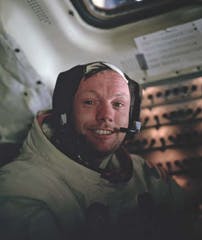Neil Armstrong photographed by Buzz Aldrin after the completion of the Lunar EVA on the Apollo 11 flight.
Photo courtesy of NASA Apollo Archive, Apollo Image Gallery.
Coming off the past few years of economic recession and uncertainty, and as many of us continue to struggle toward recovery, the recent passing of Neil Armstrong made me wistful for an era here in the United States when unimaginable accomplishments were once again accomplishable. The news of Armstrong’s death made me wonder if, and when, we would see a time when the spirit of innovation and can-do attitude will lead us to heights as lofty as Armstrong’s Apollo 11 moon landing in July 1969.
Admittedly, the Apollo 11 mission was before my time, but I’ve read and heard stories from those who were here when it happened, and I can imagine how amazing and exciting it was for Americans to see their country achieve something that surely, to many, seemed an impossible goal. As the first man on the moon, Neil Armstrong personifies the ingenuity, sense of adventure, and dogged pursuit of success that are the core characteristics of the American ethos.
Neil Alden Armstrong was born on Aug. 5, 1930, in Wapakoneta, Ohio. Before taking on the role of astronaut, Mr. Armstrong served in the Korean War as an aviator for the U.S. Navy, flying a total of 78 combat missions. While his military service interrupted his studies at Purdue University, Armstrong returned to school following the war and earned a bachelor’s degree in Aeronautical Engineering from Purdue, followed by a master’s degree in Aerospace Engineering from the University of Southern California.
In 1955, Armstrong joined the National Advisory Committee for Aeronautics (NACA), which later became the National Aeronautics and Space Administration (NASA). In 1963, Armstrong joined the astronaut program, and he and his family moved to Houston, Texas. Armstrong served as the command pilot for Gemini VIII, which was the first mission to successfully dock two vehicles in space.
In 1969, Armstrong joined fellow astronauts Edwin E. “Buzz” Aldrin and Michael Collins for the historic Apollo 11 mission to the moon. As the mission’s commander, Armstrong landed Apollo 11’s Lunar Module on the moon’s surface on July 20, 1969. Upon exiting the craft and setting foot on the moon, Armstrong offered the now famous line, “That’s one small step for man, one giant leap for mankind.”
I can only hope that in my lifetime I have the opportunity to experience an unfathomable accomplishment along the line of what Armstrong, his fellow astronauts, and the many unsung scientists, engineers, and mathematicians accomplished in making the Apollo 11 mission happen. And in this time when America is going through a bit of an identity crisis and doing some soul searching, Armstrong reminds us of the great things we’re capable of when we join together and set our sights on something as lofty as “one giant leap for mankind.” Here’s to Mr. Armstrong, those who helped take him to the moon and beyond, and the next American who does something that brings us together in amazement.
Matt Migliore is Flow Control”s Executive Director of Content. He can be reached at [email protected].



